What’s the first thing you do when your lower back hurts?
You try to stretch it in some way. it’s an intuitive action.
You try to bend down and touch your feet. You try to sit and bend over to touch your feet.
You have a feeling that it will ease the pain, and you are right.
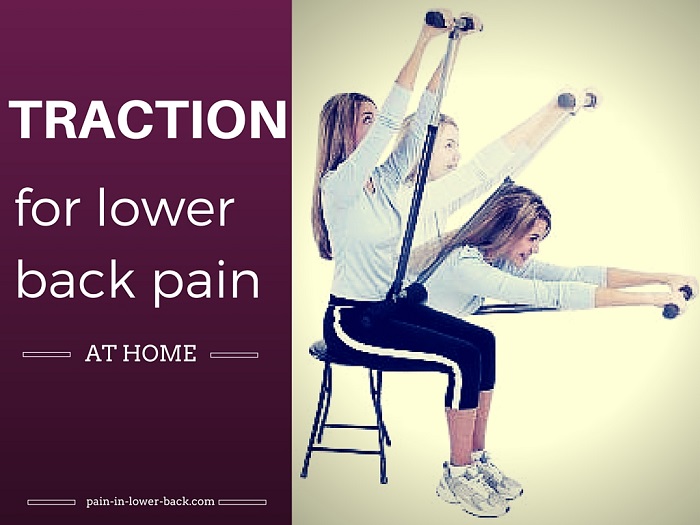
What you’re actually trying to do is lower back traction, which is pulling the top half of your body and the bottom half away from each other.
But:
While this is the right way to go, that little stretch is not likely to bring you the dramatic relief that you want NOW.
You’ll need to take it up a notch and use the best lumbar traction home devices, which is what this post is about.
In a Hurry?
See the top lumbar traction home devices compared below:
| Lumbar Traction Device | Traction Type | Effort Level |
|---|---|---|
🥇Innova ITX 9600 | Inversion table | Low effort |
| The Spinal Stretch  | Lay down back stretch bench | Low effort |
The CoreStretch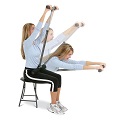 | Spine stretch | Medium effort |
| 🥇Saunders Lumbar Traction  | Lay down lumbar traction | Low effort |
| Lo Bak Trax  | Lay down lumbar stretch | Medium effort |
True Back | Lay down lumbar stretch | Low effort |
This post may contain affiliate links, at no extra cost to you.
Overview
The 3 Best Ways to Do Lumbar Traction (at Home)
As long as you won’t attempt to hang upside down on a tree branch or use the Hippocrates ladder and ropes method, you can, safely, relieve your lower back pain with a home back traction device.
The 3 Ways to do low back traction at home are:
1. Mild Traction – Spinal Decompression Exercises
Spinal decompression exercises are a mild version of low back traction.
If you do the right lower back traction exercises at home -they will slightly pull your vertebrae apart and relieve pressure on your discs, nerves, and muscles.
Watch this great example of a good exercise:
You can do this great stretch much easier and without worrying about posture mistakes if you have this lumbar stretcher (The CoreStretch):
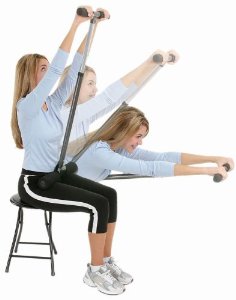
2. Moderate Traction – Back Stretchers
Back stretchers take spine decompression exercises up a notch and basically help you keep your back in proper posture when you decompress your lower back.
Through my research, The 5 best back stretchers in 2023 are:
Lo Bak Trax
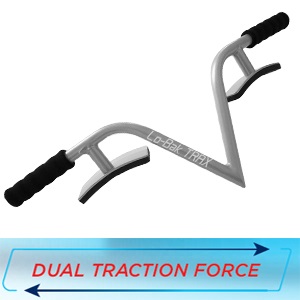
The Lo Bak Trax lumbar traction home device looks like a pair of bicycle handlebars with a deep “V” in the middle. Two curved, padded extensions are underneath each padded grip.
You lie down on your back, and pull your feet up towards your body (while your soles stay flat on the floor) – which flattens the curve in your lower back.
Then you put the Lo-Bak Trax between your legs with the pads resting on your upper quad muscle – and gently push.
This simple exercise decompresses your spine, taking the pressure off your spinal joints, discs, and nerves, and brings immediate and effective relief.
True Back Stretcher
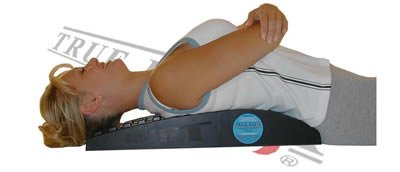
The True Back stretcher is a portable and compact lower back lumbar traction device, and easy to use. No assembly is needed and no parts can break down – ever.
You simply lie on the device, and the 30 suspension points molded into the center rails support your body weight and create pressure on the muscles on each side of the spine.
This pressure allows the muscles to completely relax, which increases blood flow. It decompresses your spine and you are passively stretching in opposite directions while being supported in the correct position.
The Spinal Stretch
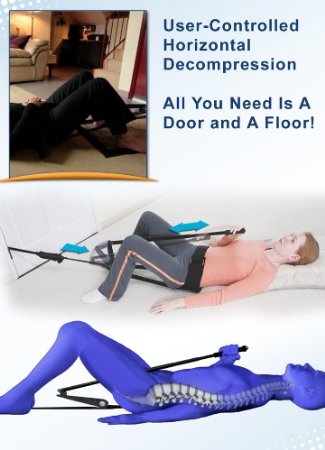
The Spinal Stretch lumbar traction home kit comes fully assembled but requires a fixed point (like a door) and a ratchet system for user-controlled tension.
It includes a metal ratchet, waist belt, traction belt, instructional DVD, and nylon tote bag.
After you strap yourself into the harness and secure the anchor point, you slowly ratchet the device that essentially pulls you towards the anchor point. Simple and effective.
Saunders Lumbar Home Traction Device
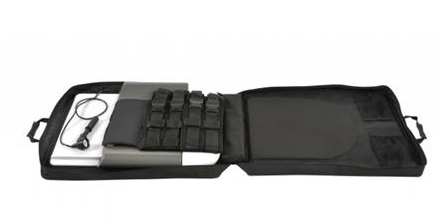
The Saunders Lumbar Traction Device is manufactured in the USA and widely used in Chiropractors’ clinics.
It has a non-slip surface to effectively grab onto the torso to provide an effective pull, and foam wedges for the head and legs are included to make application of traction more comfortable for the lumbar region.
It effectively applies up to 200 pounds of traction controlled by a patented pump/gauge that allows immediate pressure relief, if necessary, during treatment.
The Saunders HomeTrac comes with an instructional video and user’s guide, but I recommend getting specific usage instructions from your doctor, to be on the safe side.
As always, be safe and make sure you don’t have a health condition that doesn’t allow the use of traction devices. The best way to make sure is to check with your doctor first.
Always start slowly and work your way up, let your body adjust to the treatment by starting gently and gradually.
The Nubax Trio
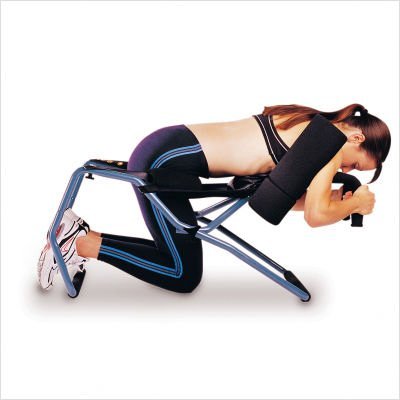
The Australian-made Nubax Trio is one of the most popular spinal decompression home devices, and for good reasons.
the Nubax Trio decompresses and stretches your spine in a way that you couldn’t possibly do on your own.
This one is a high-quality device and it takes about 10 minutes to assemble it.
The low back traction with this one is more powerful and you’ll only need one or two 3-minute sessions per day to get maximum results.
See my detailed review of the Nubax Trio (and comparison with inversion tables).
3. Powerful Traction – Inversion Table (Hanging Upside Down)

Inversion therapy is the most powerful lumbar traction therapy. Inversion exists for more than 3000 years and even the army uses it to speed up the healing of training injuries.
You strap yourself onto the table and invert in any angle that is comfortable to you. You don’t have to fully invert (hang upside down) at all.
Even a 30-degree angle is beneficial and will get the job done.
The most important factor in choosing an inversion table is safety.
Low-quality cheap tables can cause serious injuries.
One of the safest and most high-quality inversion tables is the Innova ITX9600.
You can also see my head to head comparison between the 2 best-selling inversion tables
How Does Spinal Traction Relieve Lower Back Pain?
Did you know that Hippocrates, the “father of medicine”, used spinal decompression to relieve his patients’ ailments?
He used to hoist his patients on a ladder with a series of ropes and pulleys to harness gravity, in an effort to stretch the hell out of them.
Thankfully, it’s 2023 and you won’t need a ladder and ropes.
If your low back pain is muscle-related, low back traction can almost immediately relax your muscles and increase blood flow to the area, making it heal much faster.
If your pain is spine-related, the (yet to be proven) theory is that if the discs are pulled, they will regain hydration or “enjoy” an influx of water and healing nutrients.
This will allow speedy healing and make them more shock-absorbent.
Other great benefits of lower back traction are:
1. Realigning your spine (if used long-term)
2. Improving circulation, mobility, and flexibility.
3. Improving posture – a critical preventative of future low back pain.
Does Lumbar Traction Work?
Truthfully, the research is a little mixed. Some studies prove it works, some studies prove it doesn’t. So why would you even try to do it?
1. The “Word on The Street” – so many people are thrilled with the back pain relief they’ve achieved through spinal decompression that it would be silly to not even try it.
2. Drug-free pain relief – no medication is involved here, no risking your liver and kidneys, no danger of addiction.
3. Cost-Effective – you don’t have to pay a chiropractor to decompress your lower back. You can safely do back traction at home and for a fraction of the cost.
4. More than hiding the symptoms – as opposed to conventional medicine (pain killers, steroid shots, etc), back traction can help not only considerably relieve your back pain but speed up the healing of your injury.
How Much Force of Pull is Needed?
In lumbar traction, the amount of pull needed to begin the separation of the vertebrae is half the body weight.
For example, if you weigh 180 pounds, it will take 90 pounds of pull to begin getting separation of the spinal joints and bones.
Who Should Not Do Lumbar Back Traction at Home?
DO NOT perform spinal decompression on your own if you have any of the following:
- Osteoporosis
- Spinal Fracture
- Spinal fusion surgery
- Artificial disc placement in the lower back (surgical procedure)
- Pregnant
- Increase in pain with any of these techniques
Is Lumbar Traction Painful?
Back Traction can be anything from a little painful to horribly painful, but if done correctly, it shouldn’t hurt at all.
Back traction is meant to alleviate pain, not increase it.
The best way to describe how it feels is – “a feel-good hurt“. You know what I’m talking about.
Conclusion
Back traction for lower back pain can be done at home, by yourself, while saving money and time on Chiropractor treatments.
For some people it won’t work, for others, it works remarkably well. The fact is that you won’t know if it works for you until you try it.
And now over to you:
Have you ever done back traction to relieve lower back pain? what’s your experience? Share with us in the comments below.
To your health and happiness,
Meital

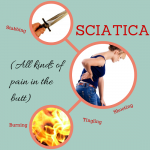
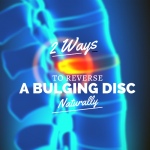
Nice article on Ways to Do Lower Back Spinal Traction. Really helped me a lot. Thank you so much for sharing…..
Ordinary chiropractors took my money for decades…40 years to be exact. My dual herniated discs and scoliosis was getting that bad. I couldn’t stand straight and my spine was badly bent from working my ass off my whole life. The only thing that saved me was a traction table and thank god I found a chiropractor who had two brand new ones. Other than him the quacks took my money without being able to do me any good for forty years.
Thanks for sharing this valuable info with us John:)
People focus on the back where the pain is but a lot of times it’s the hips that are causing pain.
Static extension is a good movement to do.
I wish someone would build a lumbar-stretch “TEETER” type hanging table, with the padded rolls, for arms/armpits, at the top, so one could hang from a heads-up vertical position.
I am older and had a few mini strokes from severe anaphylaxis bouts. My Dr. said that I should no longer hang upside down… I agreed.
Regretfully I gave away my inversion table, a wonderful source of relief….should have thought about converting for my particular problem and do my hanging safely.
Have you heard about the Nubax Trio? It’s a wonderful lumbar stretch device, without hanging upside down at all. Take a look at it here: http://amzn.to/2BKSf9T
I so agree with you I think hanging right side up is the answer but all the units I have seen for that way of doing it are very uncomfortable.
Ok, my pain is chronic, for well over a year, perhaps too many years working as a nurse. Sacral-iliac region. i have tried to control the pain with nutritional supplements: potassium, magnesium (topically and orally), calcium, silica. I avoid salt, for salt really sets off the pain. Hot-as-you-can-stand-it showers end the pain immediately, pain control lasting for about an hour foloowing the shower. Tonight thru the morning, since I could not sleep due to pain, already took a shower, I got on my exercise ball, belly to the ball, and intentionally stretched out the sacral iliac region. I just rolled on the ball until I could feel a pull in the area where I have the pain. I just laid on that ball, allowing the pull to happen, rolling every so often to cover the areas around the painful area. Probably for 10 minutes, I was draped over that ball. Got up, the R quadricept protested and hinted at spasm. But it never happened. upon getting on my feet, my back and legs felt stronger. I felt like I stood straighter and taller. I am wondering why I didn’t try this sooner. I am trying to fix this issue without the help of Rx drugs or a medical Dr., due to the opiate-addiction epidemic. It has been a tough road.
Rhea,
That’s great. You’re on the right path. This is exactly what traction does and why it’s so helpful.
I would also suggest you use an infrared heating pad instead or along with the hot showers. An infrared heating pad is safe and natural and can make you pain-free for 6 wonderful hours.
Thanks for sharing your experience with us.
Good luck!
That is a good way of doing it Rhea. I did a similar thing over the edge of my couch/arm and just stretched it out. It somehow popped my herniation back in to place because the next day I felt ok.
The problem with the discs injury’s is they only get blood for the first 3 years of life, then by age 8 they have no blood, no oxygen, and they can’t ever heal again. Thats why once you injure your back, discs etc, its so easy to re-injure and its usually worse each time, taking longer to heal. My back problems started 8 years ago when they discovered I was missing some bones in my back, spondylithiosis stage 2. Plus I am missing some lateral bone thing and I herniate discs every couple of months really bad just walking or riding a lawnmower etc.. It certainly sucks.. I am going to look into getting one of those balls though because your post reminded me of that stretch and how much it helped.
TY I am going to buy a large exercise so I can decompress my degenerated lumbar area, as I can’t use an inversion table any longer… A few severe anaphylaxis bouts caused a few mini strokes .. I like the ball therapy idea. 8)
Anytime I “stretch out” my lower back it hurts worse. I’ve found the best thing for me is to leave it alone. If it’s really bothering me, a glass of wine seems to really help.
I tried the spinal decompression at my local chiropractors office. Did not help any. In fact, it made me feel worse.
Yes, this can happen. It’s not effective for 100% of people, just like with any other treatment.
But, I would suggest trying a different chiropractor, not all of them know what they’re doing.
Why don’t you try a mild version of traction at home? Like spinal decompresion exercises? And see how you feel.
If it relieves your pain than it’s a sign that it is right for you, and chiro was wrong for you…